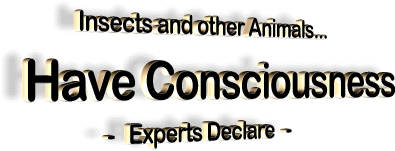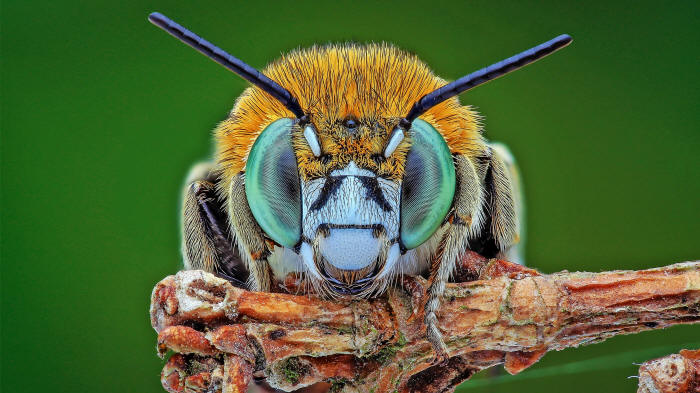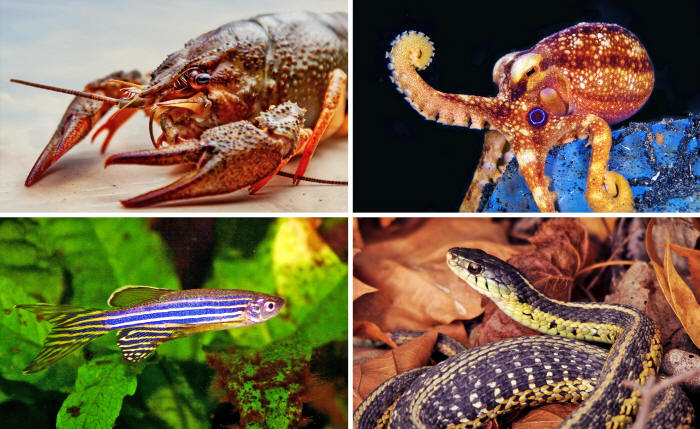|
by Dan Falk There's "a realistic possibility" of consciousness,
according to a
new declaration. biologists and philosophers announced a new consensus: There's "a realistic possibility" that insects, octopuses, crustaceans, fish and other overlooked animals experience consciousness...
In 2022, researchers at the Bee Sensory and Behavioral Ecology Lab at Queen Mary University of London observed bumblebees doing something remarkable:
Given small wooden balls, the bees pushed them around and rotated them.
The study on playful bees is part of a body of research that a group of prominent scholars of animal minds cited today, buttressing a new declaration that extends scientific support for consciousness to a wider suite of animals than has been formally acknowledged before.
For decades, there's been a broad agreement among scientists that animals similar to us - the great apes, for example - have conscious experience, even if their consciousness differs from our own.
In recent years, however, researchers have begun to acknowledge that consciousness may also be widespread among animals that are very different from us, including invertebrates with completely different and far simpler nervous systems.
The new declaration, signed by biologists and philosophers, formally embraces that view.
It reads, in part:
Inspired by recent research findings that describe complex cognitive behaviors in these and other animals, the document represents a new consensus and suggests that researchers may have overestimated the degree of neural complexity required for consciousness.
The four-paragraph New York Declaration on Animal Consciousness was unveiled today, April 19 (2024), at a one-day conference called "The Emerging Science of Animal Consciousness" being held at New York University.
Spearheaded by,
...the declaration has so far been signed by 39 researchers, including,
The declaration focuses on the most basic kind of consciousness, known as 'phenomenal consciousness'.
Roughly put, if a creature has phenomenal consciousness, then it is "like something" to be that creature - an idea enunciated by the philosopher Thomas Nagel in his influential 1974 essay, "What is it like to be a bat?"
Even if a creature is very different from us, Nagel wrote,
If a creature is phenomenally conscious, it has the capacity to experience feelings such as pain or pleasure or hunger, but not necessarily more complex mental states such as self-awareness.
A Growing Awareness
The declaration began to take shape last fall, following conversations between Sebo, Andrews and Birch.
We now know, for example, that octopuses feel pain and cuttlefish remember details of specific past events.
Studies in fish have found that,
In the insect world,
Meanwhile,
After reflecting on recent research into diverse animal minds, Jeff Sebo, Kristin Andrews and Jonathan Birch, decided to organize scientists and philosophers to sign a declaration that extends
consciousness to more animals. Kate Reeder; Ben Wulf; Maria Moore/LSE
These and other signs of conscious states in animals that had long been considered less than conscious excited and challenged biologists, cognitive scientists and philosophers of mind.
In conversations and at meetings, experts largely agreed that these animals must have consciousness.
However,
So the three researchers decided to draft a clear, concise statement and circulate it among their colleagues for endorsement.
The declaration is not meant to be comprehensive but rather,
The new declaration updates the most recent effort to establish scientific consensus on animal consciousness.
In 2012, researchers published the Cambridge Declaration on Consciousness, which said that an array of nonhuman animals, including but not limited to mammals and birds,
The new declaration expands the scope of its predecessor and is also worded more carefully, Seth wrote.
He wrote that he is,
Godfrey-Smith, a philosopher of science at the University of Sydney who has worked extensively with octopuses, believes that the complex behaviors those creatures exhibit - including problem-solving, tool use and play behavior - can only be interpreted as indicators of consciousness.
He noted that recent papers looking at pain and dreamlike states in octopuses and cuttlefish,
While many of the animals mentioned in the declaration have brains and nervous systems that are very different from those of humans, the researchers say that this needn't be a barrier to consciousness.
For example,
The nervous system of an octopus, by contrast, is complex in other ways.
Its organization is highly distributed rather than centralized; a severed arm can exhibit many of the behaviors of the intact animal.
Recent research on animal minds - including those of crayfish, octopuses, snakes and fish - suggests that consciousness "can exist in a [neural] architecture that looks completely alien" to ours,
Peter Godfrey-Smith said. Svetlana123/iStock; Colin Marshal/Biosphoto/Science Source; MATTHIASRABBIONE/iStock; Jim Maley/iStock
The upshot, Andrews said, is that,
She noted, for example, that even a cerebral cortex - the outer layer of the mammalian brain, which is believed to play a role in attention, perception, memory and other key aspects of consciousness - may not be necessary for the simpler phenomenal consciousness targeted in the declaration.
Godfrey-Smith agreed, noting that behaviors indicative of consciousness,
Mindful Relations
While the declaration has implications for the treatment of animals, and especially for the prevention of animal suffering, Sebo noted that the focus should go beyond pain.
It's not enough for people to prevent animals in captivity from experiencing bodily pain and discomfort, he said.
But the consequences of bestowing the label of "conscious" onto a wider array of animals - particularly animals whose interests we are not used to considering - are not straightforward.
For example, our relationship with insects may be,
Some pests eat crops, and mosquitoes can carry diseases.
Similarly, little attention is given to the well-being of insects such as Drosophila, which are widely used in biology research.
...said Matilda Gibbons, who researches the neural basis of consciousness at the University of Pennsylvania and has signed the declaration.
While scientific bodies have created some standards for the treatment of lab mice, it's not clear if today's declaration will lead to new standards for the treatment of insects.
But new scientific findings do sometimes spark new policies.
Britain, for example,
While the declaration makes no mention of artificial intelligence, the issue of possible A.I. 'consciousness' has been on the minds of animal-consciousness researchers.
However, what he's learned about animal minds,
Andrews hopes that the declaration will spark more research into animals that have often been overlooked, a move that has the potential to further expand our awareness of the scope of consciousness in the animal world.
|




